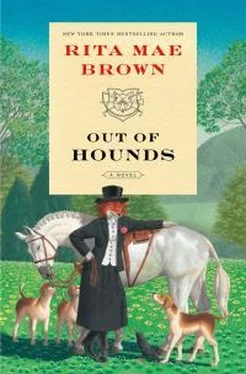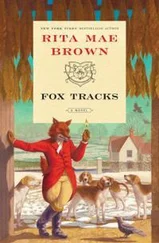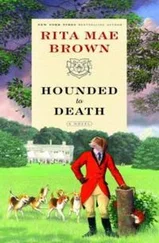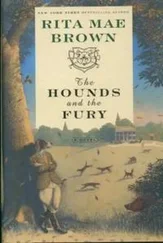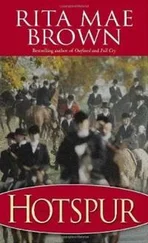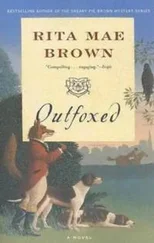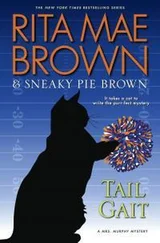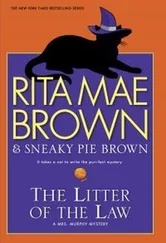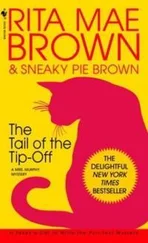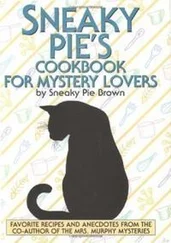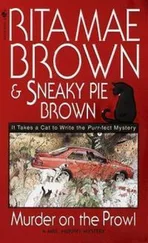Behind this structure an equivalently sized outdoor arena, a roof overhead but open otherwise, was another place to work your horse or take a lesson. Around all the large paddocks, three-board fences were white and now without lead in the paint, which meant you needed to paint them about every three years. Two if you were fussy.
Wide walkway between each paddock meant the horses couldn’t reach over and bite another horse. Most of the paddocks contained three or four horses, all of whom got along. Every paddock contained its group of friends. The walkway kept the peace.
Every paddock had a run-shed, which the horses could repair to in bad weather. But horses having an odd sense of weather as well as humor often happily stood out in a driving rain. You never knew why.
Around this, more open pastures met the eye, not yet greening up. Too early, but when spring finally did come the place would glow emerald green. Woods covered the remainder of the two-hundred-acre place, these being filled with trails, and some of these trails had natural jumps.
An office, semidetached, anchored the south side of the large stable. A covered walkway connected it to the stalls, for this way foot traffic could be controlled, keep owners at the stable. The main house could be seen in the distance, large yet simple. The design fit into the board and batten of all the wooden buildings, as did the color scheme, a deep mustard yellow with Charleston green shutters. The outbuildings all had white frames for windows but Charleston green doors, and if shutters, Charleston green.
All the supporting outbuildings echoed this color combination.
This color scheme flowed from generation to generation. Whether it came from England originally no one knew, but it was common in this New World. Hanover Shoe Farms, founded in the late nineteenth century then transformed in the early 1900s, used it for their Standardbred breeding operations.
The yellow was lighter than Showoff Stables.
One could find the colors in Maryland; Upstate New York; Lexington, Kentucky. Wherever there was a large population of horse people, this would occur.
Given that the trees with the exception of evergreens were denuded, the mustard yellow helped one focus. A wheelbarrow next to an equipment shed could easily be seen.
Willis, once the support ellipse was secured, took a moment to admire the setting. Down below, to the side of the outdoor arena, a small building, he didn’t know what it was for, had the door open. Squinting, it looked like a person’s gloved hand on the ground. Given the position of the door, he couldn’t be sure what he was seeing.
Intensely watching this hand, he counted to himself. After he reached sixty he thought he’d better hit the walkie-talkie and tell Foster to bring him down.
“Done.”
“Roger.” Foster began to lower the high bucket. Once down, Willis lifted one leg out then the other. “Foster, take a minute. Come with me.”
“Yeah, sure.” The young man with his four-day stubble cut the motor, wrapped his scarf tighter, opened the door, his feet touching the ground as he reached for his gloves in his pockets.
“Got your cellphone?”
Foster replied, “Always have my cellphone. You guys couldn’t work without me.”
“Right.” Willis, now in the middle of the beige pea-gravel road, head down, walked fast.
“Slow down.”
“Speed up. Something’s not right.”
“Willis, everything’s fine. All the markers are set. We won’t have trouble digging the cable from this point. Everybody wants stuff underground. Yeah, well, it doesn’t last but so long. They’ll have to dig it up again.”
“Thirty years from now. Hey, maybe forty. Nobody really knows. Come on, Foster. Quit dragging your ass.”
“I don’t know.”
Willis reached the outdoor arena; moving with purpose, he reached the shed. “Shit.”
Foster, now beside him, looked down at a large man, forties at the most, arm outstretched. This was the hand that Willis had seen. “Jeez.”
The man, lumberjack cap over red hair, eyes to the sky, had been strangled with a Fennell’s lead shank.
Willis tersely ordered Foster, “Call 911.”
Kneeling down, Willis didn’t touch the corpse. It seemed to him the man had not fought for his life. Perhaps his attacker was too experienced.
CHAPTER 10
February 15, 2020 Saturday
Hortensia, snug in the big hay shed at Mill Ruins, Walter Lungren’s place, listened to chatter far away. Her ears, sensitive, could hear sounds at a distance, which humans’ could not. The rumble of rigs crunching stone as they rolled down the long drive alerted her to this Saturday’s hunt. Walter put out food for the foxes at Mill Ruins, there were four in constant residence but others passed through. As it was breeding season, many a male shot through chased by James, the old red behind the mill, or Ewald, a younger red, who cleverly made a den under the back porch of the house. He also had another one at a more distant outbuilding. The house den, close to the smells of the kitchen, kept Ewald happy. Sometimes the other foxes would come by to investigate the garbage or whatever Walter threw out, but Ewald snatched up first pick being right there.
The other gray fox, the third on the property, lived acres away in the back, having a den under a large old storage building. All of the dens protected their occupants from the winds, fierce in winter. Each den had more than one entrance. There were other places to tuck in, in case of being caught unawares, that also dotted the large farm.
Yvonne Harris followed the field, driving Aunt Daniella and Kathleen Sixt Dunbar. The “girls,” as they thought of themselves, especially liked Mill Ruins. The large waterwheel, turning, water flying off the paddles, seemed to transport them to another time, maybe a better time, or so they wished.
The mill, heavy gray fieldstone, built after 1790, testified to the wisdom of our forebears. Built to stand for centuries, it did. The two-story structure, grinding equipment intact but unused, had served generations of settlers. Everyone needs grain, corn, wheat, oats. Freshly ground grain also brought in foxes, other creatures, eager for the leavings. Corn kernels spilled being carried into the mill, oats scattered, and ground fine flour dusted the wide-plank floors. All a fox had to do was wait until nightfall, eat what fell on the way to or from a wagon, or wiggle inside. James, the crabby red living behind the mill, constantly reminded Hortensia and Ewald that they were newcomers. He couldn’t do that to Grenville, living in the back at what’s called Shootrough, for his ancestors had lived here since the eighteenth century as well.
Old blood was old blood, whether vulpine or human.
Hortensia thought the whole thing silly. She liked foxhunts. She rarely gave the hounds a run but when the people left they always dropped food, even gummy bears. She loved those gummy bears.
Once the people left, Yvonne slowly driving behind, Hortensia scurried to the trailers. Most of the riders closed their tack-room doors. A few did not, so she could pop in, rummage around. Freddie Thomas usually kept the door open. Hortensia recognized the trailers as well as the humans who owned them. She’d seen them for years. She caught a whiff of the gummy bears. Freddie’s plastic bag proved no match for Hortensia, who sat there being a pig.
Ewald, slinking under a trailer, crawled out.
“Boy, there are a lot of them today. Hey, sweets!”
“The yellow ones are the best.” Hortensia fished one out.
He jumped into the tidy tack room, a regular, heavy horse blanket lying flat in the space of the nose. Curious, he easily jumped up.
“Nothing better than a horse blanket,” Hortensia said.
Читать дальше
